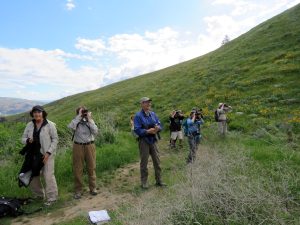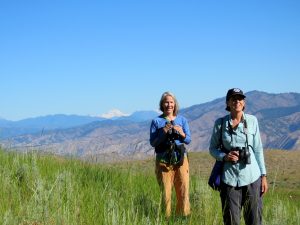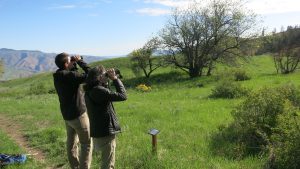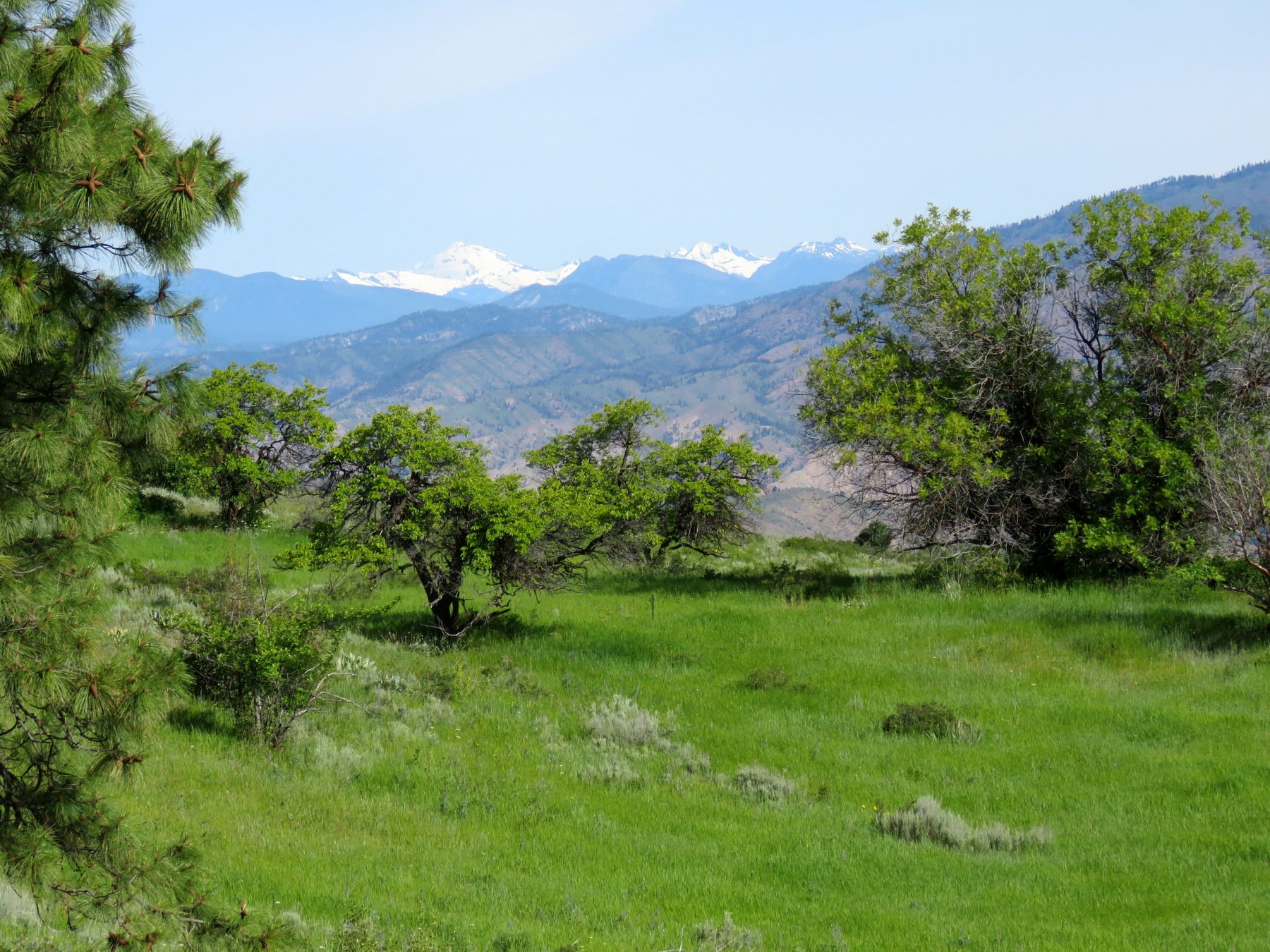Consider attending the Leavenworth Spring Bird Fest, May 15-18 2025. A series of free, pre-festival, evening trips with no registration required will be offered in Wenatchee and Leavenworth, May 12-14. On Saturday, May 17 (10am-3pm), stop by the free Bird Fest Community Fair with art and nature activities and guided nature walks at Wenatchee River Institute in Leavenworth.
by Susan Ballinger
Article in partnership with The Wenatchee World. Forty for Forty: Recognizing the 40th Anniversary of the Chelan-Douglas Land Trust with 40 stories about lands the Land Trust has protected and kept open for public access.
For many locals, a May visit to the Horse Lake Reserve is a well-known time to enjoy scenic views, wildflowers in bloom, and inviting trails. Less known is the reserve’s regional reputation among birders seeking close-up views of colorful birds. The annual Leavenworth Spring Bird Fest field trips to Horse Lake always fill quickly with avid bird-watchers carrying binoculars, cameras, and smiles. Meanwhile throughout May and June, many independent birders arrive in early morning to walk the reserve’s trails, looking and listening for over 35 different migrant songbirds that have recently arrived from their wintering grounds in the southern US, Mexico, or Central America.

What motivates me to crawl out of bed at dawn for a five-mile walk on the reserve on May mornings? The amazing combination of color, song, athletic prowess, and behavior exhibited by birds! As I pull on clothes and gulp coffee at 5:30 am, I picture the birds that have recently flown thousands of miles to this particular parcel of land. I think about the deep blue and sienna orange of the male lazuli bunting, and visualize him perched atop a serviceberry with his head thrown back, singing a sweet phrase. I imagine a streak of bright canary yellow as a yellow-breasted chat flits through a thicket of brush, singing a jumble of clucks, rattle, whistles, and squawks. I picture the white-edged dark tail and lemon-yellow belly of Western kingbirds, usually hanging out as a gang, making sharp, shrill calls. I envision a black-headed grosbeak male with a striking pattern of burnt orange, black, and white, warbling a melodious tune that goes on and on. In May, these males are all displaying their colors in hopes of attracting a mate, building a nest together, and rearing young.

The Horse Lake Reserve sits high in the northern Wenatchee Foothills where the sagebrush-grasslands, former dryland wheat fields, and forests of ponderosa pine and Douglas fir all intermix to provide diverse habitats in a compact area. Meanwhile, the trails at the reserve parallel narrow ravines choked with a chaotic jumble of shrubs like rose, mock-orange, elderberry, serviceberry, black hawthorn, red-osier dogwood, and coyote willow. This multi-storied thicket offers many species of song birds safe cover, nesting habitat, and a larder of insects and berries to feed young. At the higher elevations on the reserve, springs support groves of aspens and a shallow wetland depression, which some years is filled with water to form the pond we call Horse Lake. Here, birders can scan the aspens looking for the starts of hanging woven nests and for the flashes of black, yellow, and white of the Bullock’s orioles carrying plant fibers to finish their temporary homes.
Black snags of fire-killed ponderosa pines are also visible from the upper trails of the reserve, and these snags attract Lewis’s woodpeckers, that migrate here from their wintering grounds in the American Southwest. They require soft, decaying wood, and often take up summer residence a decade after a wildfire has created snags. These remarkable red-faced, rose-breasted birds are our region’s only woodpecker specie that nests in colonies. It is fascinating to watch their athleticism as they repeatedly fly out from a perch to snag a flying insect.
 A network of local birders serve as community-science volunteers and help the Chelan-Douglas Land Trust (CDLT) amass bird observations from the Horse Lake Reserve. These volunteers enter their bird sightings into eBird, a global project to gather data on bird abundance and distribution. The data provides scientists and researchers with real-time data. Many of us use the eBird app on our phones to easily enter observations and to discover what other birders are seeing in our area. If, for example, a friend has spotted a grasshopper sparrow at Horse Lake, I can read her entry on my app and go look for the species myself.
A network of local birders serve as community-science volunteers and help the Chelan-Douglas Land Trust (CDLT) amass bird observations from the Horse Lake Reserve. These volunteers enter their bird sightings into eBird, a global project to gather data on bird abundance and distribution. The data provides scientists and researchers with real-time data. Many of us use the eBird app on our phones to easily enter observations and to discover what other birders are seeing in our area. If, for example, a friend has spotted a grasshopper sparrow at Horse Lake, I can read her entry on my app and go look for the species myself.
Many of us also turn on the Merlin Bird ID app to record bird songs and we keep the app running as we scan for birds. The app provides a ‘best-match’ identification, a sonogram graph, and a picture of the bird it’s recording. This helps us self-check our listening and visual identifications.
Watching birds is a way to focus on the moment and be fully present in the outdoors. My favorite May moments on the Horse Lake Reserve have been in the upper apricot grove, looking at snow-capped Glacier Peak framed by a tree branch while searching and listening for a flash of color or a snippet of song. What birds are sharing this moment with me?

Details: Birding at Horse Lake
Access and Trip Instructions. On the north end of Wenatchee, drive several miles up Horse Lake Road (gravel for the last 2.75 miles) and park at the gate marking the end of the county road. Walk around the gate and follow the Old Ranch Road past the old barn (0.5 mile), continue up the two-track road another 1.3 miles to the junction with the single-track Apricot Crisp Trail. Turn left onto this trail and follow it 0.8 mile to the upper grove of apricot trees at forest’s edge. Retrace your steps to return to the trailhead. Most trail junctions within the reserve have posts with wayfinding maps.
Allowed: Birding, nature exploring, hiking, trail running, mountain biking, horseback riding, dogs on leash.
Not Allowed: No motorized vehicles or drones; hunting or shooting; camping, campfires or nighttime use.
Distance: 5.25 miles roundtrip. Elevation Gain: 1,025 vertical feet.
Preferred Season: April-October.
Land Ownership. This outing is entirely on property owned and managed by CDLT
Permits: None needed.
Links and Resources
- Explore bird sightings here.
- Download the free Merlin Bird ID phone app. The app allows identification of bird songs in real time and helps identify birds with a photo.
- Carry CDLT’s Wenatchee Area Field Guide ($10 donation suggested).
- Click here for a list of plants found on the reserve.
Events. Consider attending the Leavenworth Spring Bird Fest, May 15-18. A series of free, pre-festival, evening trips with no registration required will be offered in Wenatchee and Leavenworth, May 12-14. On Saturday, May 17 (10am-3pm), stop by the free Bird Fest Community Fair with art and nature activities and guided nature walks at Wenatchee River Institute in Leavenworth.
Tip. Birding is more fun with binoculars. If you lack a pair, borrow from relatives or friends. And if you’re considering buying, this article will help.
Susan Ballinger is a North Central WA Audubon Society volunteer bird guide for Leavenworth Spring Bird Fest. She serves as a biologist consultant as part of the CDLT Stewardship team and is the founder of the Wenatchee Naturalist program.


